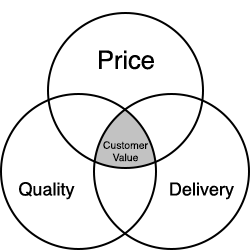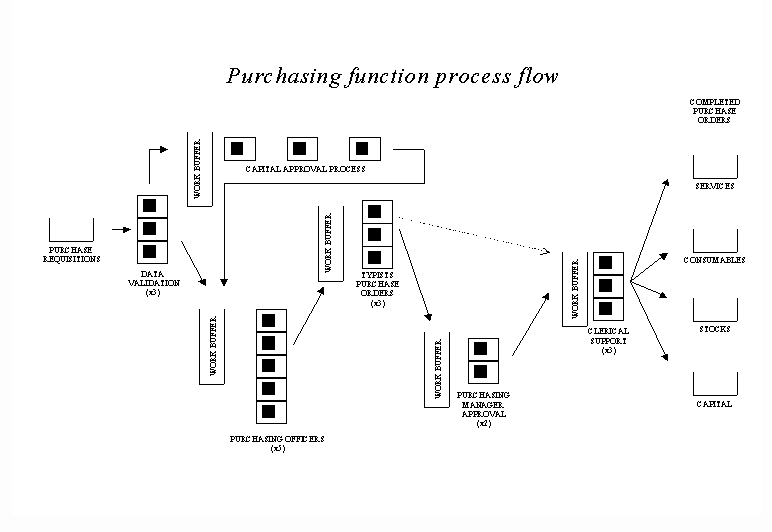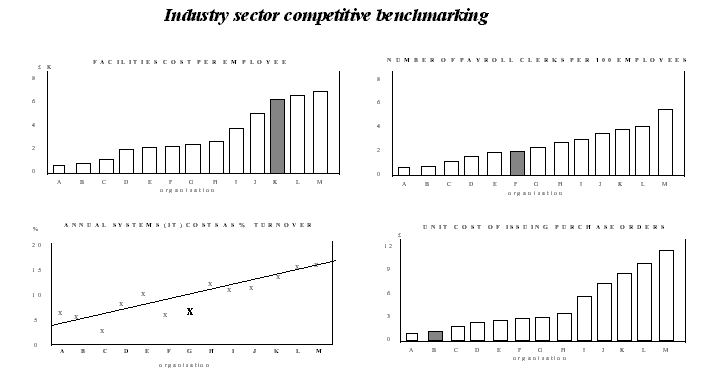Value From Cost
The ability of an organisation to compete over the long term is a vital concern to management. Organisations which have successfully traded through the economic cycles of recent decades have maintained their investment in productive assets, R&D and people.
These resources are the foundations of any organisation. It is possible to improve, enhance and maintain them, but to cut deeply to meet short-term expediencies erodes the long term stability of the organisation’s structure, and results in the loss of productive assets and skilled staff. We help our clients develop and implement strategies for continuous cost improvement. We focus on providing value to the customer, and eliminating costs that do not match customer requirements. The key features of our Value from Cost methodology are:
- Customer focus: what does the customer require?
- Process flow analysis: what internal processes are needed to meet those requirements?
- Value added: how can activities which add little or no value to the product or service be identified and eliminated?
Continuous improvement: how can an organisation align, and keep aligned, its cost base with its long-term corporate goals?
Customer Value

Every successful organisation, whether public or private, manufacturing or service based, has a common goal – to provide value to its customers or clients. Customer value is a function of quality, delivery and price. The objective of an organisation’s internal processes must be to increase quality and delivery performance, and improve productivity, to offer competitive price.
Each of these components is important, but performance can only be improved if the organisation knows and manages the real cost of its operations. Cost includes all the resources of an organisation, including people, equipment, data and facilities, used to meet the quality and delivery requirements of the customer. Our approach to cost management is to optimise the value obtained from the mix of resources the organisation needs to meet customer requirements.
Cost Management
We define effective cost management as a set of techniques and methods for planning, implementing, measuring and reporting, designed to improve the productivity of an organisation’s products/services and related processes. Our approach identifies how resources such as labour, equipment and materials are expended on activities which support an organisation’s existing portfolio or products and services. We break down the processes involved into individual activities and groups of activity in order to identify inefficiencies, duplication or waste. Over time an organisation tends to develop a fairly rigid organisational structure, with established methods, procedures and reporting systems which people are reluctant to change. Lasting cost improvements are achieved by concentrating on mainstream, or core, activities which add value to the organisation’s products/services, and reducing the resources on non-core activities which do not add value. We test the validity of the organisation’s infrastructure through an analysis of its customers’ needs and establish how these are met by the organisation as a whole. We identify those supporting processes which cut across departmental lines of accountability, often creating pools of cost incurred to meet purely internal needs. The emphasis of our work is to identify :
- Waste: activities that add no value to the final product as perceived by the customer ;
- Inefficiency: operating processes that are complex, duplicated etc. and which extend the overall process time;
- Instability: processes which are erratic or which are subject to unpredictable levels of input or output;
- Gaps: areas where the needs of the customer are not met.
We make use of two powerful management tools :
- Dynamic simulation: we use computer-based simulation techniques to help management understand and improve the processes and workflows in their organisation;
- Competitive benchmarking: we use competitive benchmarking to establish comparisons with competitors’ costs.
Dynamic Simulation

We use computer-based dynamic simulation modelling of an organisation’s processes to provide a moving image of operations. This demonstrates visually the routing of products, services, paper and data through machines, service points, clerks or computer networks. This visual, interactive approach provides a panoramic view of complex processes, and enables managers from all disciplines, such as finance, operations, IT services, clearly to communicate ideas and solutions through a common language. The models we develop are designed to focus on the use of key resources - skilled people, equipment, facilities. Management can review the impact of changes in product/service demand and mix on critical areas, including:
- resource utilisation;
- process flow bottlenecks;
- distribution of common resources to a number of products or services.
These operational models are supported by a subsidiary, integrated financial model we have developed to show the cost impact of changes in projected product/service volume and mix, and resource capacities. This operational-financial link is shown in the diagram on the facing page. It provides management with real information against which to control their business, significantly more useful than costs based on historic events.
Competitive Benchmarking
Projected costs can be compared with industry benchmark costs and "what-if" analyses can be carried out to help optimise the way in which operations are structured and managed. Competitive benchmarking provides invaluable information for management to compare cost performance, both historic and projected, with competitors and/or comparable operations. Organisations have traditionally set internal targets as part of their annual planning process, but without the external perspective management cannot know whether the target is demanding enough. Benchmarking provides externally validated targets against which to develop long-term cost improvement plans. These targets may often be derived from readily available published information but where necessary we carry out survey-based research directly with comparable organisations.

Product Costing
Once an organisation has established an understanding of its cost structure and has set targets to align it with its long-term corporate goals, the next objective is to understand the real cost of individual products and services. Our approach to product/service costing resolves the problems caused by current costing systems:
- Poor pricing decisions;
- Poor product/service rationalisation decisions;
- Unreliable and unsubstantiated management information.
Unlike traditional cost accounting systems which spread overhead costs to products/services often on an arbitrary basis, such as numbers employed, we seek to identify the root causes of cost in all departments and sections. Based on this work we can accurately assign costs to products and services based upon the amount of each resource consumed in the process of manufacturing a product or providing a service. Our approach makes use of spreadsheet-based financial models. They include those costs which are normally excluded from costing systems such as administration, sales, marketing and distribution. This enhanced and more relevant costing approach provides management with information to help analyse product/service profitability by customer and market channel.